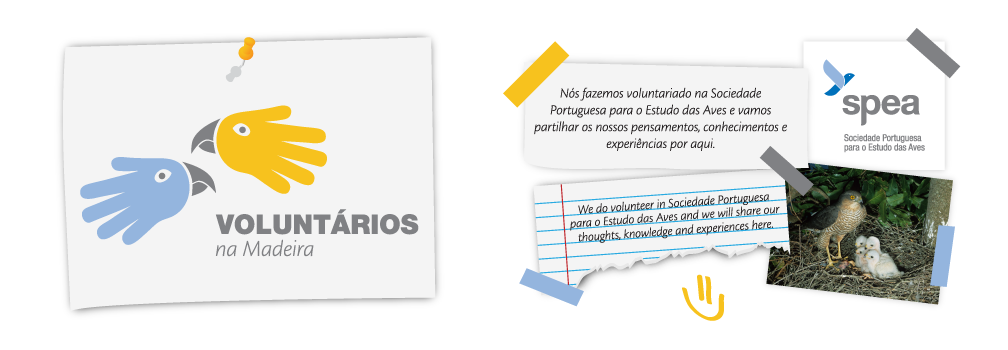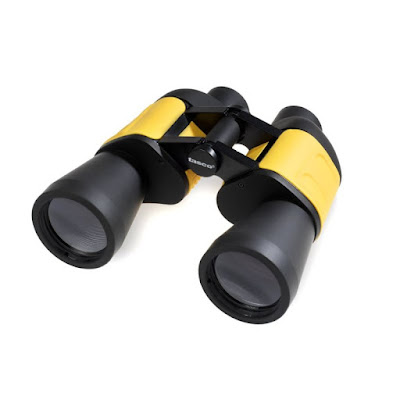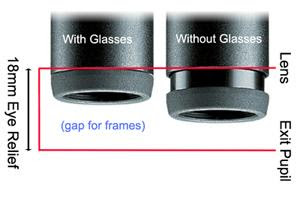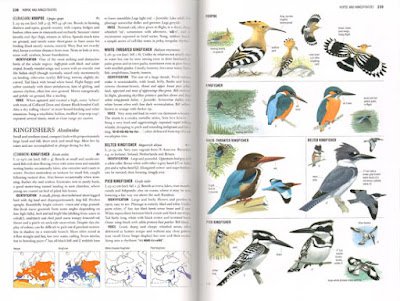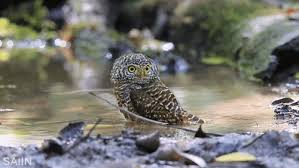Field of view
The field of view is a very important feature that must be taken into account choosing your equipment, it is a difficult concept to explain, so I will try to do it the best i can, when we observe through binoculars , our vision covers a certain area, the field of view is that width measured in meters at a distance of 1000 meters, for example if binoculars have a field of view of 122 meters, it means that we will cover a portion of 122 meters The line perpendicular to our vision that is 1000 meters away. I put this photo because I think it is eassier to understood
As I said before, for a bird-watcher, the field of vision is very important, due to that when biger it is, it will be easier to locate the birds, especially when we are trying to "follow" small and swift birds such as The Bis-Bis.
Focus
Surely you know that most binoculars have a central wheel that can "turn", well, it serves to focus, that is, to "focus on what we want to see" within our field of view.
Within this characteristic, what interests us is the minimum distance of focus, this is the minimum distance to which an object has to be, so that we can see it well with the binoculars.
Therefore, we are interested in being as low as possible, many people say that binoculars with a minimum distance of approach of 8 meters, is enough, I personally consider that this should be 5 meters, with this we can appreciate in a way all the amazing details of that little bird that has gotten us very close uswhen, in fact the minimum focus distance of my binoculars is 3 m and couldn't be more satisfied.
Another thing to keep in mind is that in the market there are some models that do not bring focus wheel, and that are "pre-focused" a certain distance, DO NOT BUY one of these models, because to observe birds aren't useful.
Within this characteristic, it should also be said that almost all binoculars have a diopter corrector system, located in one of the eyepieces (usually in the right), this is very useful because, it is usual that we don't have the same ability to see in both eyes. This system is very simple, it is a "little wheel" that we must turn to get an adequate view, but despite being simple, I have to say that without some indications, it is a bit complicated to know how to adjust them.
Eye relief
Another feature that we have to take into account is the eye relief. I will not explain much about this concept, because is more complicated than the previous ones, the important thing that we have to know here is that the greater this distance is, it will be more comfortable be looking through the binoculars. In general, the vision will be comfortable from 1 centimeter, if we have to bring the eyes closer we will cause eye fatigue, which in a long time is very annoying and can cause damage to our vision. It is a particularly important factor for observers who need glasses, because in this case the accommodation distance should be about 1.5 centimeters.
Currently almost all binoculars have adjustable adapters that allow us to modify this distance, being of great help when we use binoculars people wearing glasses and people who don't.
Materials
Apart from the optical materials of binoculars, we must take into account that the rest of the components are made, because the materials of the frame will determine their resistance to external agents.
Firstly, as for the materials from the outside, we find them from poor quality plastics to rubber, I recommend one of rubber materials, because they protect much more of any blow and makes that their grip is easier, especially in rainy conditions. Obviously we must treat them with care, but in the field it is very possible that we give them some other blow.
Another factor to take into account is water resistance, generally in the market we find two types of denominations: "wäter resistant" and "wäter proof", the first type resist external splashes, while the second types can be used under the Rain and even can be submersible. Certainly, I recommend that they be the second type, at first glance are somewhat more expensive, but it is a worthwhile investment, since you never know when we have to "cross" a river to see a particular species or when it will rain.
Another factor that is fundamental for me is that they need to be "foog proof", which means that the inside of the binoculars is filled with nitrogen or argon, which prevents fogging in areas of high humidity or sudden changes in temperature The optical components thereof, thus avoiding the yellowing of the lenses, which is so common in older models. Initially this feature was only found in high-end binoculars whose prices were exorbitant, however, we can now find very affordable price binoculars that have this "life insurance".
Are you going to use them for?
Finally, I am going to talk about something that we have to take into account, in what kind of environments we are going to use them, as you can imagine, it is not the same to observe birds in a forest, that in a steppe or in the sea.
Basically, if we are going to observe birds in a forest, what interests us is a good light, focus on nearby objects and a good field of view to follow the rapid movements of passerines. So, for me, the best option is one 8x42 binoculars that have the features that i mentioned above.
However, if we are going to observe birds at great distances such as steppe species or mountain birds, what we need will be a good range, so I recommend using about 10x42 or if the weight is not a problem about 10x50.
On the contrary of what one would think, if we are going to observe seabirds, we need about 7x42 or 7x50 since we are interested in minimizing the vibrations produced by the rocking of the boat, and the bigger the increases, the greater these vibrations, for what 7 increases is the optimum value for that modality.
And here ends this "brief guide" to the purchase of good binoculars, I hope to have explained more or less clearly all the concepts and that you have enjoyed reading it 😊
--------------------------------------------------------------------------------------------------------------------
Hoje vou continuar a minha guia para escolher uns bons binóculos, no meu artigo anterior eu expliquei algumas das características básicas que temos que ter em mente para comprar binóculos, neste artigo vou expandir essa informação, para que você possa ser um especialista ao fazer um investimento tão importante como este.
Campo de visão
O campo de visão é uma característica muito importante que deve ser levado em conta ao escolher a nosso equipe, é um conceito difícil de explicar, quando olhamos através de uns binóculos, a nossa visão abrange uma determinada área, porque o campo de visão é a largura, medida em metros a uma distância de 1000 metros, ou seja, se os binóculos têm um campo de visão de 122 metros meios que irão cobrir uma porção de 122 metros perpendicular à nossa visão é de 1000 metros de linha. Na seguinte foto aprecia-se meior
Como eu já disse antes, para um bird-watcher, o campo de visão é muito importante porque, quanto maior, mais fácil será para localizar as aves, especialmente, no caso de indivíduos pequenos e rápidos como o Bis-Bis.
Focar
Certamente você já sabe que a maioria dos binóculos têm uma roda central que "pode virar", isso serve para focar, em outras palavras, para "se focar no que queremos ver" dentro do nosso campo de visão. Neste recurso, o que nos interessa é a distância mínima de foco, a distância mínima que deve ser um objeto, para que possamos vê-lo bem com os binóculos.
Portanto, queremos ser tão baixa quanto possível, um par de binóculos com uma distância focal mínima de 5 metros é suficiente.
Outra coisa a considerar é que alguns modelos não trazem roda de foco, e são "pré-focado" a uma certa distância, NÃO COMPRAR um destes modelos no mercado, já que para a observação de aves não são nada útil.
Neste recurso, deve-se dizer que quase todos os binóculos têm um sistema corrector de dioptrias localizado em umo dos oculares (Normalmente à direita), isto é muito útil como é de costume, não têm a mesma capacidade de visão em ambos os olhos, iste sistema é muito simple, é uma "pequena roda" que devemos voltar para obter a visão correta, mas apesar de ser simples, devo dizer que sem algumas indicações preliminares, é um pouco difícil saber como ajustar.
Para fazer isso, primeiro olhar somente através da ocular da esquerda (se o sistema corrector é à direita) e com a roda central focar um objeto, em seguida, olha apenas o ocular direito e foque usando o sistema corrector localizado no ocular.
Distancia de acomodação do olho
Outra característica que temos que levar em conta a distância de acomodação do olho, ou "eye relief".
Não vou explicar muito sobre este conceito, pois é um pouco mais complicado do que o anterior, o importante que precisamos saber aqui é que quanto maior é a distância, mais confortável nós estaremos olhando através dos binóculos.
No geral, a visão será confortável a partir de 1 centímetro. É um fator especialmente importante para os observadores que precisam de óculos, porque neste caso a distância de alojamento deve ser de cerca de 1,5 centímetros.
Atualmente quase todos os binóculos têm alguns adaptadores ajustáveis que permitem modificar essa distância, sendo útil ao usar os binóculos é não.
Materiais do montagem
Além dos mareriais ópticos dos binóculos, devemos ter em mente que eles são feitos os outros componentes que irá determinar a resistência delos contra agentes externos, e depois de um grande esforço econômico, acho que todos nós queremos uns binóculos que duram tanto tempo quanto seja possível, não é?.
Em primeiro lugar, em termos de materiais fora, encontramos a partir de má qualidade plástico, a borracha ou de borracha, eu recomendo que você é um destes últimos materiais, uma vez que proteger mais de qualquer acidente vascular cerebral e marcas seu aperto mais fácil, especialmente em condições de chuva. É óbvio que eles devem ser tratados com cuidado, mas no campo é bem possível que nós damos alguns tiros reais, portanto, quanto mais "-lo protegido" são melhores.
Outro fator a considerar é a resistência à água, geralmente no mercado temos dois tipos: “wáter resistant” e “wáter proof” os de primeiro tipo podem resistir salpicos externos, enquanto os de segundo tipo pode ser usado com chuva e pode até ser submersível.
Eu definitivamente recomendo os que são do segundo tipo, à primeira vista, eles são mais caros, mas é um investimento que vale a pena, pois você nunca sabe quando temos de atravessar uma ribeira para ver uma determinada espécie ou quando vamos apanhar chuva.
Outro fator que é essencial para mim é que eles são "foog proof", isto significa que os binóculos interior é preenchido com nitrogênio ou argônio, o que impede, quem áreas de elevada humidade ou de mudanças bruscas de temperatura, os componentes ópticos ambasiam-se.
Para o que os vai usar?
Finalmente, vou falar sobre algo que temos de considerar, no que tipo de ambiente os vamos usar?, Como você pode imaginar, não é o mesmo a observação de aves em uma floresta, quem um estepe ou no mar.
Basicamente, se vamos observar aves numa floresta, o que precisamos é uma boa luz, pôr focar em objetos próximos e um bom campo de visão para seguir o movimento rápido de os passeriformes. Então, para mim, a melhor opção é um 8x42 com as características que eu mencionei acima.
No entanto, se quisermos observar as aves por longas distâncias, como as espécies de estepe ou as aves de montanha, precisa-se de um bom aumento, portanto, recomendamos o uso de um 10x42 ou se o peso não é um impedimento sobre a 10x50.
E aqui termina esta "pequena guia" para escolher uns bons binóculos, espero ter explicado de forma mais ou menos clara todos os conceitos e que você gostou da leitura. 😊
